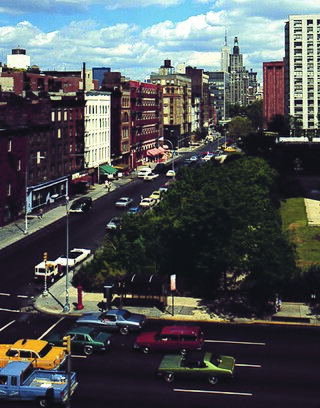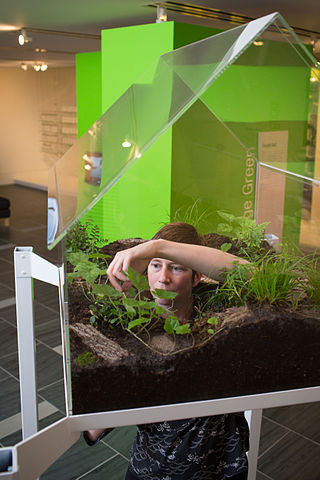
Land art, variously known as Earth art, environmental art, and Earthworks, is an art movement that emerged in the 1960s and 1970s, largely associated with Great Britain and the United States but that also includes examples from many countries. As a trend, "land art" expanded boundaries of art by the materials used and the siting of the works. The materials used were often the materials of the Earth, including the soil, rocks, vegetation, and water found on-site, and the sites of the works were often distant from population centers. Though sometimes fairly inaccessible, photo documentation was commonly brought back to the urban art gallery.

Site-specific art is artwork created to exist in a certain place. Typically, the artist takes the location into account while planning and creating the artwork. Site-specific art is produced both by commercial artists, and independently, and can include some instances of work such as sculpture, stencil graffiti, rock balancing, and other art forms. Installations can be in urban areas, remote natural settings, or underwater.
Public art is art in any media whose form, function and meaning are created for the general public through a public process. It is a specific art genre with its own professional and critical discourse. Public art is visually and physically accessible to the public; it is installed in public space in both outdoor and indoor settings. Public art seeks to embody public or universal concepts rather than commercial, partisan, or personal concepts or interests. Notably, public art is also the direct or indirect product of a public process of creation, procurement, and/or maintenance.

Alan Sonfist is a New York City based American artist best known as a "pioneer" and a "trailblazer" of the Land or Earth Art movement.

James Wines is an American artist and architect associated with environmental design. Wines is founder and president of SITE, a New York City-based architecture and environmental arts organization chartered in 1970. This multi-disciplinary practice focuses on the design of buildings, public spaces, environmental art works, landscape designs, master plans, interiors and product design. The main focus of his design work is on green issues and the integration of buildings with their surrounding contexts.

Environmental art is a range of artistic practices encompassing both historical approaches to nature in art and more recent ecological and politically motivated types of works. Environmental art has evolved away from formal concerns, for example monumental earthworks using earth as a sculptural material, towards a deeper relationship to systems, processes and phenomena in relationship to social concerns. Integrated social and ecological approaches developed as an ethical, restorative stance emerged in the 1990s. Over the past ten years environmental art has become a focal point of exhibitions around the world as the social and cultural aspects of climate change come to the forefront.

Experiments in Art and Technology (E.A.T.), a non-profit and tax-exempt organization, was established in 1967 to develop collaborations between artists and engineers. The group operated by facilitating person-to-person contacts between artists and engineers, rather than defining a formal process for cooperation. E.A.T. initiated and carried out projects that expanded the role of the artist in contemporary society and helped explore the separation of the individual from technological change.
Mierle Laderman Ukeles is a New York City-based artist known for her feminist and service-oriented artworks, which relate the idea of process in conceptual art to domestic and civic "maintenance". She has been the Artist-in-Residence at the New York City Department of Sanitation. Her art brings to life the very essence of any urban center: waste flows, recycling, sustainability, environment, people, and ecology.
Maja and Reuben Fowkes are London-based curators, critics and art historians who investigate engagements in contemporary art with ecology, climate change and the Anthropocene. They also deal in their work with the art history of the former socialist territories of Central and Eastern Europe, the Soviet Union and beyond.

Tanya Preminger, is an artist working in various media: environmental art, site-specific art, ephemeral art, sculpture, installation and photography. She is mostly known for her land art projects and large-scale stone sculptures.

Patricia Johanson is an American artist. Johanson is known for her large-scale art projects that create aesthetic and practical habitats for humans and wildlife. She designs her functional art projects, created with and in the natural landscape, to solve infrastructure and environmental problems, but also to reconnect city-dwellers with nature and with the history of a place. These project designs date from 1969, making her a pioneer in the field of ecological-art Johanson's work has also been classified as Land Art, Environmental Art, Site-specific Art and Garden Art. Her early paintings and sculptures are part of Minimalism.

Internet art is a form of new media art distributed via the Internet. This form of art circumvents the traditional dominance of the physical gallery and museum system. In many cases, the viewer is drawn into some kind of interaction with the work of art. Artists working in this manner are sometimes referred to as net artists.
Ecological art is an art genre and artistic practice that seeks to preserve, remediate and/or vitalize the life forms, resources and ecology of Earth. Ecological art practitioners do this by applying the principles of ecosystems to living species and their habitats throughout the lithosphere, atmosphere, biosphere, and hydrosphere, including wilderness, rural, suburban and urban locations. Ecological art is a distinct genre from Environmental art in that it involves functional ecological systems-restoration, as well as socially engaged, activist, community-based interventions. Ecological art also addresses politics, culture, economics, ethics and aesthetics as they impact the conditions of ecosystems. Ecological art practitioners include artists, scientists, philosophers and activists who often collaborate on restoration, remediation and public awareness projects.

Nature Belle, a public artwork by American artist Roy Staab, was located in the middle of a round-about at the intersection of the Hank Aaron Trail and 25th Street, near Milwaukee, Wisconsin. A site-specific sculpture constructed from natural local materials, the finished bell was supported by a box elder tree and was approximately 45 ft. in height and 35 ft. in diameter. Located in the center of a busy traffic circle, it was viewed mostly by passing motorists. Like most of Staab's ephemeral sculptures, the work is no longer extant. It was completed on June 6, 2006, and destroyed by a storm on September 8, 2006.

Vaughn Bell is an environmental artist working with sculpture, installation, performance and video, who lives and works in Seattle, Washington. Vaughn received her MFA from the Studio for Inter-related Media at Massachusetts College of Art in Boston, MA and her undergraduate degree from Brown University, where her work focused on "Nature and Culture: Human Perspectives on the Natural Environment".
Ecovention was a term invented by Amy Lipton and Sue Spaid in 1999 to refer to an ecological art intervention in environmental degradation. The Ecovention movement in art is associated with land art, earthworks, and environmental art, and landscape architecture, but remains its own distinct category. Many ecoventions bear tendencies similar to public works projects such as sewage and waste-water treatment plants, public gardens, landfills, mines, and sustainable building projects.

Mary Miss is an American artist and designer. Her work has crossed boundaries between architecture, landscape architecture, engineering and urban design. Her installations are collaborative in nature: she has worked with scientists, historians, designers, and public administrators. She is primarily interested in how to engage the public in decoding their surrounding environment.

Andrea Bowers is a Los Angeles–based American artist working in a variety of media including video, drawing, and installation. Her work has been exhibited around the world, including museums and galleries in Germany, Greece, and Tokyo. Her work was included in the 2004 Whitney Biennial and 2008 California Biennial. She is on the graduate faculty at Otis College of Art and Design.
Meg Webster is an American artist from San Francisco working primarily in sculpture and installation art. While her works span multiple media, she is most well known for her artworks that feature natural elements. She is closely affiliated with Post-Minimalism and the Land Art movement and has been exhibiting her work since 1980.

Giovanni Aloi is an author and curator specializing in the representation of nature in modern and contemporary art. He teaches art history and visual culture at School of the Art Institute of Chicago. He is the Founder and Editor in Chief of Antennae: The Journal of Nature in Visual Culture and is the co-editor of the University of Minnesota Press book series Art after Nature. Aloi is also USA correspondent for Esse Magazine Art+Opinion.














